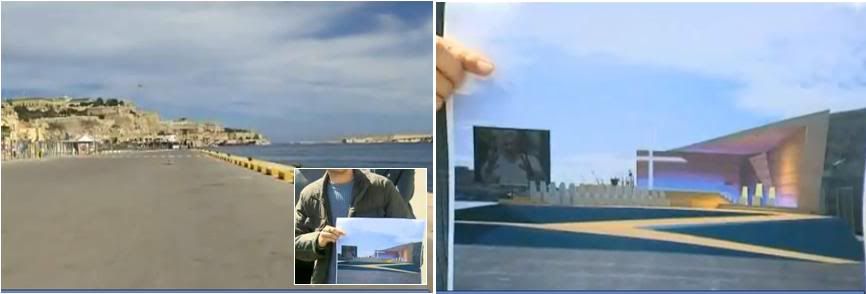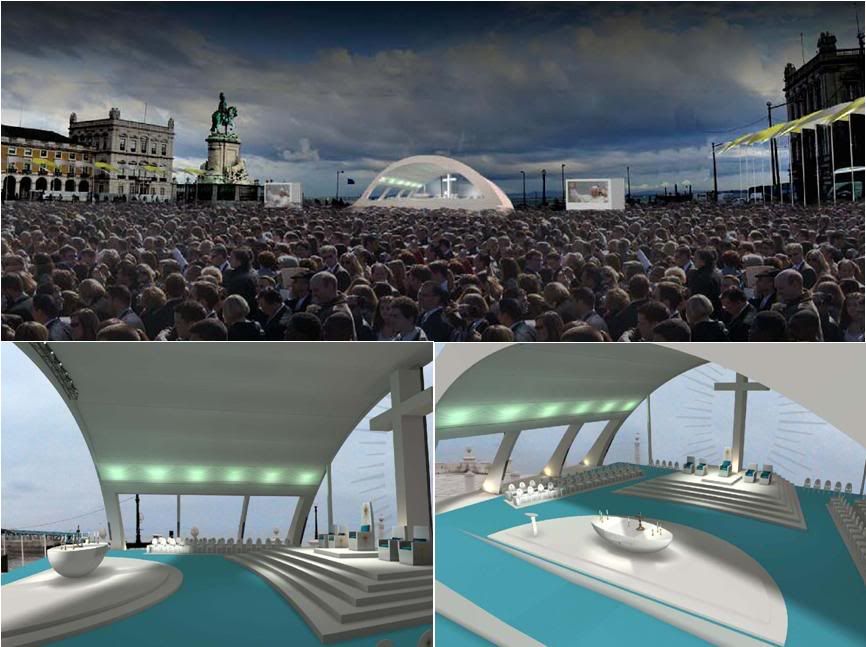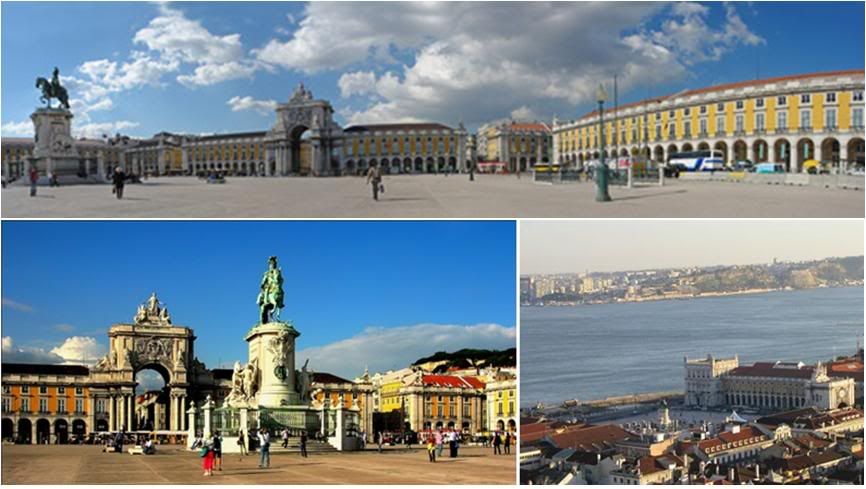

 Is 500 all the young people
Is 500 all the young people
they can come up with?

March 2, 2010

Over 500 young people will be participating in an activity to welcome Pope Benedict XVI at the Valletta Waterfront next April.
The activity will include a concert made up of different bands and in which young people will share their experiences with the Pope.
The design for the stage was conceived by a number of youths under the direction of designer Carlo Schembri.
A better story from the Times of Malta:
14,000 expected for Pope's
youth meeting in Valletta

March 2, 2010
The organisers of the Papal visit today unveiled the designs of the stage to be used for the Pope's meeting with young people at Valletta Waterfront in the afternoon of Sunday, April 18.
They expect some 14,000 young people to turn up.
Architect Daniel Darmanin, speaking for the team which designed the stage, said that the focus of the structure would be the Cross and then the Pope, who leads Man to God.
The organisers explained that activities will kick off at 2 p.m. with performances featuring various Christian bands and solo artistes.
The Pope will arrive at Valletta Waterfront at 5.15 p.m. on a catamaran from Kalkara. Addresses will then be made by youths, representing those who are active in the church, young families, those who do not feel they are part of the church, and those preparing for the priesthood.
Pope Benedict will deliver his own address and reply to the comments.
The one-hour activity will also feature prayer with the Pope.
Activities will continue after the Pope leaves, including a guest appearance by Winter Moods.
Fr Savio Vella SDB, the Archbishop's delegate for young people, said the Valletta Waterfront would feature a 'youth village' with stands by various youth organisations and areas for counselling services.
The organisers expect some 14,000 young people to turn up.
Participants are urged to to register on
www.popemalta.org

Earlier, the organizing committee for the visit said Pope Benedict XVI is expected to pass through 33 different localities in his Popemobile during his short visit to Malta next April.
However, the Pope is not expected to stop in any of these localities but the route has been chosen to include going by old people’s homes so that the sick and elderly may be able to see him at close range.
More on this from the Times of Malta - and a controversy that ought to be resolved easily - if the tIme and distance considerations are as described:
Local council protests that Pope's
Malta route does not lead north
by Herman Grech

The Mellieħa council believes the Pope should be driven through their village, even though
the 83-year-old Pontiff is visiting 40 Maltese parishes in just 26 hours.
The council has filed an official protest to the committee overseeing the Pope's visit, saying it fails to understand why he cannot make a short detour to the north.
"The Mellieħa sanctuary and St Paul's Islands are synonymous with our Christianity. It is only natural that the Pope should visit them," Mellieħa Mayor Robert Cutajar told
The Times.
The Pope is visiting Malta in connection with the celebrations marking 1,950 years since St Paul landed in Malta.
He said the council was reflecting residents' anger that Pope Benedict XVI was not following in the footsteps of his predecessor, who had stopped to bless the Mellieħa sanctuary during his visit in 1990.
The Pope will visit Malta on April 17 and 18 - being driven through several streets before celebrating Mass on the Floriana granaries.
But it appears some localities want to take an even closer look at the head of the Roman Catholic Church.
"In the name of the Mellieħa community, I would like to show my disapproval as mayor, that my locality has not been included (in the routes)," Mr Cutajar wrote to the chairmen of both the Church and government organising committees.
Mellieħa has close ties with the Christian faith, as highlighted especially by St Paul's Islands (which fall under the council's jurisdiction) and the Mellieħa sanctuary, the mayor wrote.
Mr Cutajar told the committee that the Mellieħa sanctuary was one of just 20 in the world dedicated to Our Lady of Lourdes. St Luke is also known to have accompanied St Paul to Malta and was responsible for painting the image of Our Lady at the sanctuary.
"The Pope travels around the world so much - is it possible that he cannot travel an extra 15 minutes by car via St Paul's Bay and Mellieħa?" the mayor said.
Mr Cutajar even suggested the Pope be taken on a boat for a quick tour to the Gozo harbour, passing by St Paul's Islands, without disembarking.
He urged the organisation committee to revise the programme, maybe even with the intervention of the Vatican. Charles Bonello, chairman of the National Organisation Committee who is also Mr Cutajar's colleague at the Office of the Prime Minister, replied, saying it was impossible to include Mellieħa on the route since it was distant in relation to the program prepared for the Pontiff.
Mgr Charles Cordina, chairman of the Curia committee, said he was sorry he could not satisfy everybody's requests because of time constraints, which also precludes the Pope from visiting other significant venues - like the Gozo diocese, San Ġorġ Preca's museum Society and St John's Co-Cathedral in Valletta.
The Popemobile will be driven slowly to allow the people to see the Pope, who will be greeted with bands in some localities. Where possible, the vehicle will be driven near old people's homes, monasteries and town centres.


The Portuguese bishops conference has issued a pastoral note to the faithful about the Pope's visit in May.
(However, it is so far available only in Portuguese. I will post when translated).
Later today, the organizing committee for the Pope's visit, led by the auxiliary bishop of Lison, Mons. Carlos Azevedo, released today the sketches for the atage and altar to be erected in Liscon's main square, the Terreira do Paco (Palace Square), the old name still used by man for what is now called the Praca do Comercao, where the Holy Father will celebrate Mass on the evening of May 11.


The Terreiro do Paco is the size of about two and a half football fields, one of the largest public squares in Europe. It is in the lower part (Baixa) of old Lisbon on the banks (Ribeira) of the Tagus river, opening out towards the river.
It was built on the site of the old Palace Square and the two centuries-old Ribeira royal palace after the great earthquake and tsunami of 1755 destroyed most of Lisbon.
The palace was rebuilt inland. The equestrian statue on the square is that of King Jose I, who was king during the earthquake. The Baixa of Lisbon was declared a world heritage site by the UNESCO in 2004.
[Modificato da TERESA BENEDETTA 03/03/2010 22:03]